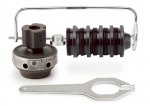Good idea - you could even cut a coupling so it is short enough both nipples thread in far enough to hit each other.
You have to use a threading that has adjustable dies for different pipe sizes. Typical hand threading dies will not let you thread this as the coupling will not fit into the head that holds the dies.
I don't use couplings. For some reason they like to jam to the conduit and it sucks trying to get them off.
I make a piece with 8 to 10 inches of running thread on one side of about a foot long stick of pipe. Then, I flip the pipe around and clamp the running threads into the threader. Next, I thread the pipe so that only about 1/8 to 1/4 of an inch is left not threaded.
Now all that is left is to cut the pipe (on both ends if necessary) so that only the tapered part (about 3/4 of an inch) is left on each side.
Caveat: If you don't use a coupling it's real easy to squish the pipe in the threader if you are trying to clamp onto running threads. A sharp die and lots of oil really helps matters. Oh, and pay attention if you are using the threader to cut pipe where it has been threaded. The cutter likes to follow the threads and if you aren't quick.....let's just suffice it to say it's better to cut the pipe with a saw. :ashamed:
The last one I did was in a steel mill where we were 20 minutes from our supply con box in the dead of winter. I was showing my foreman how to do it with an old nasty Rigid threader with dull dies. It took three tries, but I finally got one cut. It took me about a half hour as I did not lose my temper. So that was 1/2 hr J-man pay plus 1/2 hour foreman pay and a stick of pipe.
What's that, about $120 (total package, union scale) for a close nipple?

Not really avoidable since it would have been a 40 minute round trip PLUS rooting through the con box for a close nipple (that may not have even been there).



